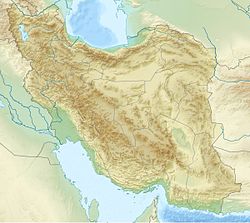Shah Abdol-Azim Shrine
| Shah Abdol-Azim Shrine | |
|---|---|
شاه عبدالعظیم | |
 | |
| Religion | |
| Affiliation | Shia (Twelver) |
| Ecclesiastical or organizational status | Mosque and imamzadeh complex |
| Status | Active |
| Location | |
| Location | Rey, Ray County, Tehran Province |
| Country | Iran |
Location of the funerary complex in Iran | |
 | |
| Geographic coordinates | 35°35′08″N 51°26′07″E / 35.58556°N 51.43528°E |
| Architecture | |
| Type | Islamic architecture |
| Style | |
| Completed | 9th century CE |
| Specifications | |
| Dome(s) | One |
| Minaret(s) | Two |
 | |
| Official name | Shāh Abdol-Azīm Shrine |
| Type | Built |
| Designated | 1942 |
| Reference no. | 406 |
| Conservation organization | Cultural Heritage, Handicrafts and Tourism Organization of Iran |
The Shāh Abdol-Azīm Shrine (Persian: شاه عبدالعظیم; Arabic: مرقد الشاه عبد العظيم الحسني)[a] is a Twelver Shi'ite funerary monument and religious complex, located in Rey, in the province of Tehran, Iran. The complex contains the tomb of ‘Abdul ‘Adhīm ibn ‘Abdillāh al-Hasanī[4] (aka Shah Abdol Azim). Shah Abdol Azim was a fifth generation descendant of Hasan ibn ‘Alī[4] and a companion of Muhammad al-Taqī.[4] He was entombed here after his death in the 9th century CE.
Adjacent to the shrine, within the complex, are the mausolea of Imamzadeh Tahir (son of the fourth Shia Imam Sajjad) and Imamzadeh Hamzeh (brother of the eighth Twelver Imām - Imām Reza).
The complex was added to the Iran National Heritage List in 1942, administered by the Cultural Heritage, Handicrafts and Tourism Organization of Iran. The complex is one of the holiest sites in Twelver Shi'ism.
Background
[edit]Abdol Azim migrated to Ray out of persecution[4] and subsequently died there. A piece of paper was found in his pocket outlining his ancestry as being: ‘Abdul ‘Adhīm son of ‘Abdillāh son of ‘Alī son of Hasan son of Zayd son of Hasan ibn ‘Alī.[4] Shah Abdol Azim was sent to Ray (modern-day Tehran) by Imam Reza.
History and design
[edit]Ibn Qūlawayh al-Qummī (d. 978 CE) "includes the shrine in his Kāmil al-Ziyārāt, one of the earliest pilgrimage guides for the Shiʿa, which suggests that the tomb of ʿAbd al-Aẓīm was already of some importance by the tenth century."[5][6] The tomb of Abdol-Azim had also come under the patronage of Sunni rulers at times, a notable example being the mausoleum constructed over Abdol-Azim's tomb in the 1090s CE by orders of the Seljuk vizier Majd al-Mulk Asʿad b. Muḥammad b. Mūsā.[7][8][9][10]
This door has an inscription in Thulth script.
Notable burials
[edit]In addition to Abdol-Azim al-Hassani, the shrine is the burial site for many notable individuals, including members of the Qajar family, and many notable political figures, scholars, and clerics, from the Medieval period to contemporary times.
Gallery
[edit]See also
[edit]Notes
[edit]References
[edit]- ^ "Abdol Azim Hasani". iribnews.ir.
- ^ "Shrine of Shah Abdol-Azim". aparat.com.
- ^ "Shah Abd al-Azim". mashreghnews.ir.
- ^ a b c d e al-Qummi, Ja'far ibn Qūlawayh (2008). "107". Kāmil al-Ziyārāt. trans. Sayyid Mohsen al-Husaini al-Mīlāni. Shiabooks.ca Press. p. 658.
- ^ Ibn Qūlawayh al-Qummī, Kāmil al-Ziyārāt (Beirut, 1418/1997), pp. 536–537
- ^ Bernheimer, Teresa. "Shared Sanctity: Some Notes on Ahl al-Bayt Shrines in the Early Ṭālibid Genealogies" (PDF). Archived from the original (PDF) on August 15, 2019.
- ^ ʿAbd al-Jalīl b. Abū al-Ḥasan al-Qazwīnī (fl. 1189), Kitāb al-Naqḍ (Tehran, 1371/1952), p. 220
- ^ W. Barthold, An Historical Geography of Iran (Princeton, 1984), p. 127
- ^ Sheila Blair, The Monumental Inscriptions from Early Islamic Iran and Tran-soxania (Leiden, 1992), p. 185
- ^ Leisten, Architektur für Tote, pp. 240–241.
Further reading
[edit]- Kondo, Nobuaki (2018). "State and Shrine in Iran: Waqf Administration of the Shah ͑ Abd al-͑ Azim Shrine under the Qajars". In Miura, Toru (ed.). Comparative Study of the Waqf from the East: Dynamism of Norm and Practice in Religious and Familial Donations. Tokyo. pp. 1–25.
{{cite book}}: CS1 maint: location missing publisher (link) - Kondo, Nobuaki. "The Shah ʿAbd al-ʿAzim Shrine and its Vaqf under the Safavids".
External links
[edit]![]() Media related to Shah Abdol-Azim Shrine at Wikimedia Commons
Media related to Shah Abdol-Azim Shrine at Wikimedia Commons
- 9th-century religious buildings and structures
- Buildings and structures in Tehran province
- Mausoleums, shrines and tombs on the Iran National Heritage List
- Imamzadehs in Iran
- Mausoleums in Iran
- Mosque buildings with domes in Iran
- Mosque buildings with minarets in Iran
- Mosques in Iran
- Safavid architecture in Iran
- Shia mosques in Iran
- Tourist attractions in Tehran province
- Twelver Shia mosques
- Twelver Shia shrines
















